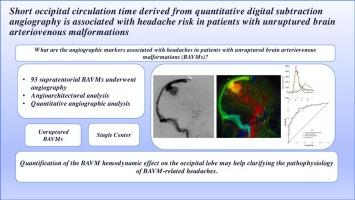Short occipital circulation time derived from quantitative digital subtraction angiography is associated with headache risk in patients with unruptured brain arteriovenous malformations
IF 3.3
3区 医学
Q1 RADIOLOGY, NUCLEAR MEDICINE & MEDICAL IMAGING
引用次数: 0
Abstract
Purpose
To explored key angiographic markers associated with headache risk in patients with unruptured brain arteriovenous malformations (BAVMs).
Methods
This retrospective study included patients with unruptured, supratentorial BAVMs without prior interventions who underwent digital subtraction angiography between January 2011 and January 2024. The patients were stratified into headache and nonheadache groups on the basis of symptoms at initial presentation. Patient data and angiograms were analyzed to explore BAVM characteristics and quantitative digital subtraction angiography (QDSA) parameters. Data on occipital circulation time—defined as the interval between the bolus arrival time in the cavernous internal carotid artery and that in the occipital vein and measured using lateral DSA ipsilateral to the BAVM—were collected. Multivariate logistic regression was performed to identify key factors associated with BAVM-related headaches.
Results
This study included 93 patients, among whom 50 (53.3 %) presented with headaches. The multivariate analysis revealed that female sex, occipital BAVM location, venous reflux in the superior sagittal sinus, and occipital circulation time <2.37 s were independently associated with BAVM-related headache risk. We developed a model that combined angioarchitectural features and QDSA results; the model exhibited improved performance in determining BAVM-related headache risk (area under the curve: 0.854).
Conclusions
Female sex, occipital BAVM location, venous reflux in the superior sagittal sinus, and a short occipital circulation time are associated with headaches in patients with unruptured BAVM. QDSA can objectively quantify hemodynamic changes in patients with BAVM-related headaches.

定量数字减影血管造影显示枕循环时间短与未破裂脑动静脉畸形患者头痛风险相关
目的探讨与未破裂性脑动静脉畸形(BAVMs)患者头痛风险相关的关键血管造影指标。方法回顾性研究纳入2011年1月至2024年1月期间未经干预的幕上未破裂BAVMs患者,并行数字减影血管造影。根据患者最初出现的症状将患者分为头痛组和非头痛组。分析患者资料和血管造影,探讨BAVM特征和定量数字减影血管造影(QDSA)参数。收集枕循环时间数据,定义为药物到达海绵样颈内动脉和到达枕静脉的时间间隔,并使用与bavm同侧的侧位DSA测量。进行多变量logistic回归以确定与bavm相关头痛相关的关键因素。结果本研究纳入93例患者,其中50例(53.3%)出现头痛。多因素分析显示,女性、枕部BAVM部位、上矢状窦静脉回流、枕部循环时间2.37 s与BAVM相关头痛风险独立相关。我们开发了一个结合血管建筑学特征和QDSA结果的模型;该模型在确定与bavm相关的头痛风险方面表现出更好的性能(曲线下面积:0.854)。结论女性、枕部脑血管瘤位置、上矢状窦静脉回流、枕循环时间短与未破裂脑血管瘤患者头痛相关。QDSA可以客观地量化bavm相关性头痛患者的血流动力学变化。
本文章由计算机程序翻译,如有差异,请以英文原文为准。
求助全文
约1分钟内获得全文
求助全文
来源期刊
CiteScore
6.70
自引率
3.00%
发文量
398
审稿时长
42 days
期刊介绍:
European Journal of Radiology is an international journal which aims to communicate to its readers, state-of-the-art information on imaging developments in the form of high quality original research articles and timely reviews on current developments in the field.
Its audience includes clinicians at all levels of training including radiology trainees, newly qualified imaging specialists and the experienced radiologist. Its aim is to inform efficient, appropriate and evidence-based imaging practice to the benefit of patients worldwide.

 求助内容:
求助内容: 应助结果提醒方式:
应助结果提醒方式:


